Exploring The Grand Canyon North Rim – Traveler Guide
The Grand Canyon North Rim is quiet, private, and offers a wide variety of hiking trails. The higher overlooks and wider perspective give you unmatched views compared to the south rim. Many people consider the north rim “the real Grand Canyon” because of the pristine environment and solitary viewpoints.
The North Rim is the least-visited side of the canyon which makes it feel even more rugged and remote.
In this article, we’re going to cover the best areas to explore on the Grand Canyon’s North Rim including overlooks and scenic drives, hiking, camping, and lodging.
- Check out these other National Parks in Arizona
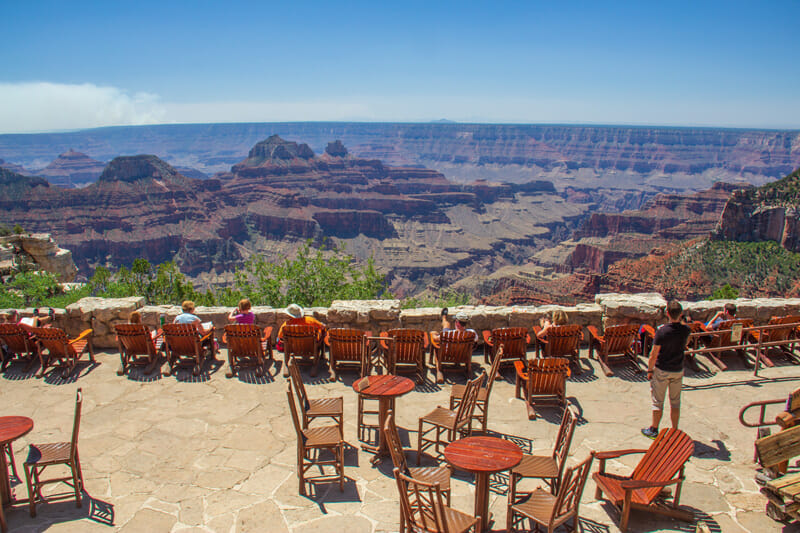
Grand Canyon North Rim VS South Rim
The Grand Canyon North Rim and South Rim entrances are located 4-hours apart and they are vastly different in nature.
The north rim is more remote and located further from major cities. For that reason, it’s much quieter and less populated. In fact, the north side only receives 10% of the visitors that the south rim experiences.
- Located 5 hours from Las Vegas
- Located 3 hours from St. George, UT
The north side is much smaller, with only about 23 miles of paved road between the North Rim Visitor Center and Cape Royal Overlook (the southernmost trail). There are also significantly fewer amenities.
It is 1,000 feet higher in elevation than the south rim and roughly 10 degrees cooler. Birch, maple, oak, and aspen trees flourish throughout the area in addition to ponderosa pines. A variety of plants gives it glorious fall colors, unlike the south which has more of a desert feel.
Heavy snow in winter means that the north rim has a short visitor season. The roads, buildings, and other amenities are only open between mid-May to mid-October. In contrast, the Grand Canyon south rim is open year-round.
On the north rim, the scenic overlooks highlight the width of the canyon; whereas the south rim is known for displaying its depth. The north side also has fewer views of the Colorado River below.
North Rim Grand Canyon
- Higher elevation
- Cooler, wetter climate
- Larger variety of trees
- Less populated
- Smaller area
- More secluded overlooks
- Fewer amenities
- Facilities closed in winter
South Rim Grand Canyon
- Lower elevation
- Dry, desert climate
- Closer to major cities
- More tourists
- Variety of visitor services
- Popular overlooks and trails
- Open year-round

Grand Canyon North Rim Weather
The best time to visit the Grand Canyon North Rim is during summer. In July, temperatures will peak in the mid-70s. Nighttime temperatures drop into the low 40s. This is perfect weather for hiking, camping, or gathering for a family picnic with a view.
Fall brings spectacular colors that you can’t experience on the south rim. Mid-September is the best time to visit the north rim if you want to see the changing leaves.
Amenities and services on the Grand Canyon north rim are closed during winter. In fact, north rim roads are closed between December 1 – May 15. So you should plan to visit between May and October to get the full experience.
Winter backpacking, snowshoeing, and cross-country skiing however, can be a fun way to visit the area with a backcountry use permit.

Visitor Center And Amenities
There are significantly fewer amenities on the north rim compared to the south. This includes just one visitor center, a gas station, a general store, and one hotel–The Grand Canyon Lodge.
Getting Around
No shuttle buses operate on this side of the canyon so you’ll need to drive around on your own. Larger vehicles like an RV can easily get to the North Rim Visitor Center, but winding roads will inhibit vehicles longer than 30 feet from traveling beyond that point.
Things To Do On The Grand Canyon North Rim
Remote and breathtaking landscapes make hiking and auto tours the most popular activities to do on the north rim. We highly recommend packing some snacks and spending the day along the rim. Consider picnicking near an overlook. There are numerous pullouts and rest areas with a view.
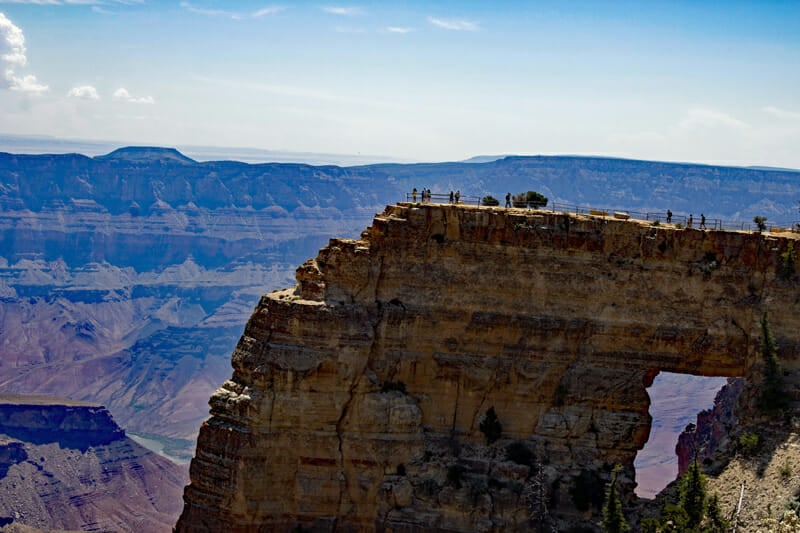
North Rim Scenic Drives And Overlooks
Unlike the south rim where some viewpoints are hidden, you’ll get to experience awe-inspiring views from nearly every road the north rim. The North Rim visitor center is the typical starting point for every auto tour. So before taking off, walk-in and grab a map.
If you have the entire day, there is enough time to take a scenic drive to all five of the most breathtaking overlooks. The drive is just 28 miles from end-to-end.
- Point Imperial
- Vista Encantada
- Roosevelt Point
- Walhalla Overlook
- Cape Royal
The roads along the auto route are single lane and winding. You should not take a vehicle over 30ft on these because there are no easy turnaround points. If you have an RV, it’s best to stick to the trails and overlooks around the visitor center.
Each of the overlooks and viewpoints are just off the road. That means you won’t need to hike very far to capture the overwhelming beauty of the canyon.

Photography Tips
Use a lower aperture setting to take crisper photos of the Grand Canyon landscape. A lower ISO will be the best for details and a greater range of colors.
For the best pictures, grab your camera and head for the trail during the golden hour. This is shortly before sunrise and just before sunset each day.
The best viewpoints for photography on the Grand Canyon North Rim are:
- Point Imperial
- Bright Angel Point
- Cape Royal

North Rim Day Hiking
Because of the smaller crowds, hiking on the north rim is a much more solitary experience than the south. Travelers who prefer to get off the beaten path particularly enjoy the rugged nature of the north rim.
There is a variety of short and long hikes so every type of traveler can experience the canyon.
| North Rim Trails | Total Distance | Hike Time |
|---|---|---|
| Bright Angel Point | 0.5 mi | 30 min |
| Transept Trail | 3 mi | 1.5 hr |
| Bridle Trail | 2.4 mi | 2 hr |
| North Kaibab Trail | 1.5 - 28 mi | varies |
| Ken Patrick Trail | 20 mi | 12 hr |
| Uncle Jim Trail | 5 mi | 3 hr |
| Widforss Trail | 10 mi | 6 hr |
| Arizona Trail | >10 mi | varies |
| Cape Royal Trail | 0.6 mi | 30 min |
| Cliff Springs Trail | 1 mi | 1 hr |
| Cape Final Trail | 4 mi | 2 hr |
| Roosevelt Point Trail | 0.2 mi | 20 min |
| Point Imperial Trail | 0.4 mi | 2 hr |
Hiking To The Bottom Of The Rim
While the majority of the hikes cruise around the top of the canyon, the North Kaibab Trail is only one on the north rim that zigzags into the canyon. Hiking from the top of the rim down to the Colorado River and back is 28 miles round trip and it’s extremely strenuous.
The North Kaibab Trail is so intense that you should not attempt to do it in a single day. There is a 6,000 foot elevation drop to the river below along with the same climb on the way back out. For those who want to go backpacking, permits are available for overnight camping.

Fortunately, as an out and back loop you can hike a small section of the trail and still fully appreciate the beauty of the Grand Canyon. Coconino Overlook (1.5 miles) and Supai Tunnel (4 miles) are attractive turnaround points.
For a full-day hike, you can take the North Kaibab Trail down to Roaring Springs and back up. The round trip journey is 9.4 miles and even the most experienced hikers will be exhausted at the end.
Don’t forget–even on the North Rim, temperatures get extremely hot in summer. You’ll want to pack accordingly and don’t forget to brings lots of water. There are no drinking fountains along the trails or within the canyon.
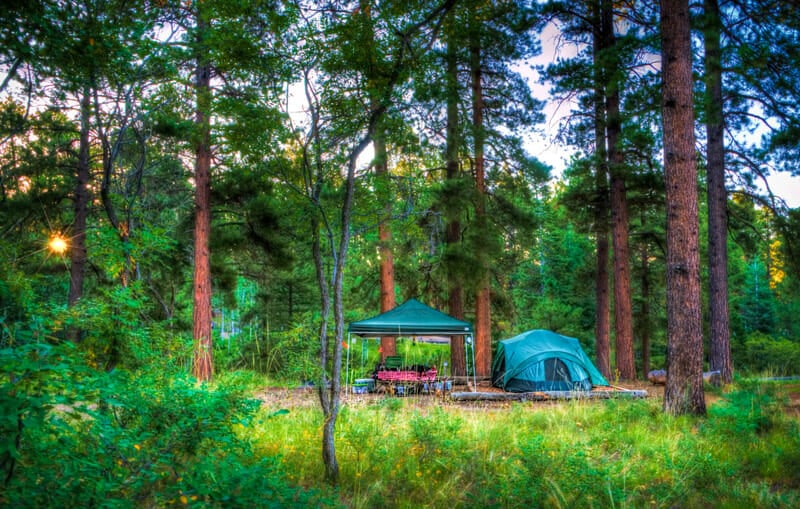
Camping On The North Rim
There is no better way to experience the canyon than by camping on the north rim. The Grand Canyon has some of the most incredible sunrises and the best way to capture it is by spending the night.
In The Park: North Rim Campground
There is just one campground with amenities located on the North Rim: the North Rim Campground. It’s located just a mile from the visitor center. Campsites are tent camping only, and start at $18/night. Although they don’t have electric hookups, there are hot showers and laundry on the road to the campground. There is also a dump station on the premises.
The North Rim Campground is reservation required May 15 – October 15 and first come, first serve the rest of the year. There are 90 campsites.
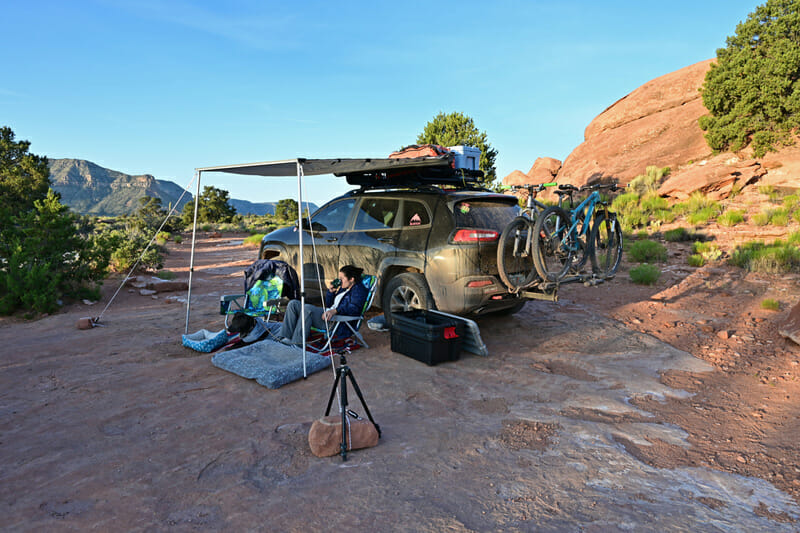
Primitive Camping: Tuweep Campground
Tuweep campground is a primitive campsite located nearly a 5-hour drive west of the North Rim entrance station. There are 9 campsites here that require a backcountry permit. High clearance vehicles are required and four wheel drive is recommended. Because of its remote location, Tuweep is not easy to get to. But that also means you won’t see many neighbors and you’ll get some of the best views in the canyon all to yourself.
Dispersed Camping And Backpacking
Camping is permitted throughout the bottom of the Grand Canyon for hikers that are doing multi-day trips, ski-campers and rafters. You’ll need to obtain a permit through the backcountry information center.
Campgrounds Outside The Park
If the North Rim Campground is full, or if you’re traveling in an RV – you still have options. There are three campgrounds nearby that you might want to take a look at: DeMotte Campground, Jacob Lake Campground, and Kaibab Camper Village.
| DeMotte Campground | Jacob Lake Campground | Kaibab Camper Village |
|---|---|---|
| 7mi from park entrance | 44mi from park entrance | 44mi from park entrance |
| May 15 – October 15 | May 15 – October 15 | May 15 – October 15 |
| 38 sites | 51 sites | 46 sites |
| Tent/Small Trailers | Tent/Small Trailers | Tent + RV friendly |
| No Electricity | Electric/Non-Electric sites | Electric Hook-ups |
| Vault Toilets | Vault Toilets | Toilets/ Shower/ Laundry |
| $18/night | $20+/night | $20+/night |
Each of these campgrounds is open mid-May to mid-October. They all take reservations, but also have walk-up sites. DeMotte and Jacob Lake are dry camping sites, with vault toilets and few amenities. These are tent camping only campgrounds.
Kaibab Camper Village is where you’ll want to stay if you visit the Grand Canyon in an RV. Their campsites can accommodate larger motorhomes and have electric hookups, showers and laundry. All of these campgrounds are pet friendly.
Lodging
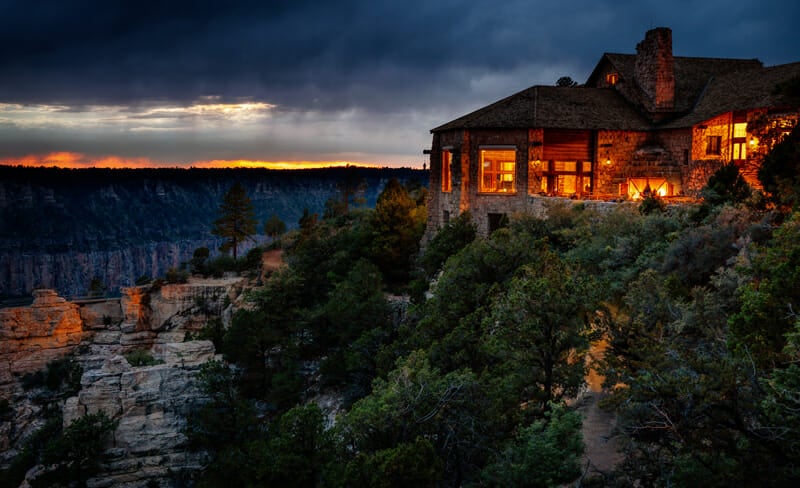
In The Park: Grand Canyon Lodge
The Grand Canyon Lodge is the only hotel in the park on the North Rim. The lodge has a series of small cabins lined along the rim and a larger structure with motel rooms inside. Floor to ceiling windows in the dining room give you spectacular views right from the table, and it’s only a short walk away from some of the best hiking on the rim.
Reservations fill up fast so you’ll want to plan ahead. Bookings can be made up to 13 months in advance. We recommend taking a look at the hotel map ahead of time and booking a cabin on the perimeter or the structures. Some rooms have better views of the canyon from the front porch than others.
Outside The Park: Page, Arizona
Outside of the park, your best bet for finding a variety of hotels and dining options is spending the night in Page, Arizona. Page is located about 2.5 hours north of the rim. That may seem far, but the distance is why so few people visit the north rim.
If you choose to stay in page, Antelope Canyon, and Horseshoe Bend are two attractions that you cannot miss!
How Long Should You Stay?
There are less viewpoints on the north rim than the south, but they are spread further apart. So it will take more time to drive and hike to them. Although you can see all the overlooks in one long day, you should set aside 2-3 days to do some hiking and take in the sights.
Traveling To The South Rim
Traveling between the Grand Canyon north and south rims is a 4 hour drive around the outside of the park. The Trans-Canyon shuttle runs twice a day in each direction The shuttle ride lasts 4.5 hours and costs over $90 for a one way ticket.
We highly recommend spending a few days at each rim to fully appreciate the features of the Grand Canyon.

Appreciating the time and effort you put into your website and in depth information you offer. Sounds like it was quite the adventure! Say you just wanted to hike down, then up one side in a day or over a couple of days – with kids. Which side would you recommend as being more ‘kid-friendly’? You mentioned on the north rim that if you were averse to heights or steep sides that one may have a hard time hiking that – is the trail on the south end more forgiving that way? Thanks!